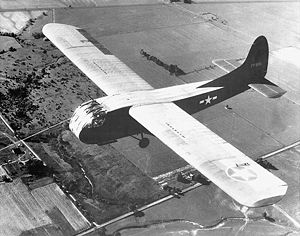![]() The Pacific War Online Encyclopedia
The Pacific War Online Encyclopedia
|
| Previous: Wachi Takaji | Table of Contents | Next: Waco CG-13, Allied Glider |

U.S. Air Force.
Via Wikipedia
Commons
Waco CG-4
| Passengers | 1 pilot and 13 soldiers |
| Dimensions | 83'8" by 49'8" by 13'7" 25.20m by 14.83m by 3.84 m |
| Weight |
3440 lbs 1560 kg |
| Tow speed | 150 miles per hour 241 km/h |
| Capacity |
4060 lbs (1842 kg) cargo |
| Production |
13,909, primarily at the Ford Motor Company plant in Kingsford MI |
The Waco was one of the most widely used Allied gliders of the war,
participating in the Normandy and Holland operations in Europe and in
the Burma campaign in the Far East. Constructed of small gauge steel tubing with a canvas skin and a honeycomb plywood floor that allowed it to carry more than its own weight in cargo and passengers, its
entire nose section could be swiveled up to permit rapid loading and
unloading of troops or equipment. The latter might be a jeep with supply trailer, a mountain artillery piece, or a small bulldozer. It was typically towed to its landing zone by a C-47 using a 300' (100 meter) nylon rope.
The glider had a basic instrument cluster that included an air speed indicator, an altimeter, a rate of climb indicator, and a bank and turn indicator. All were originally designed for conventional aircraft and had a tendency to stick in the absence of normal engine vibration, so that the glider pilots had to frequently tap on the instruments to get correct readings.
The gliders were intended to be reusable, but in practice they were almost universally viewed as expendable by theater commanders.
The British called the design the Hadrian, and constructed a large number at airfields around Calcutta.
References
Aviastar.org (accessed 2010-7-13)
Wood (2002; accessed 2010-10-8)
The Pacific War Online Encyclopedia © 2010-2012 by Kent G. Budge. Index